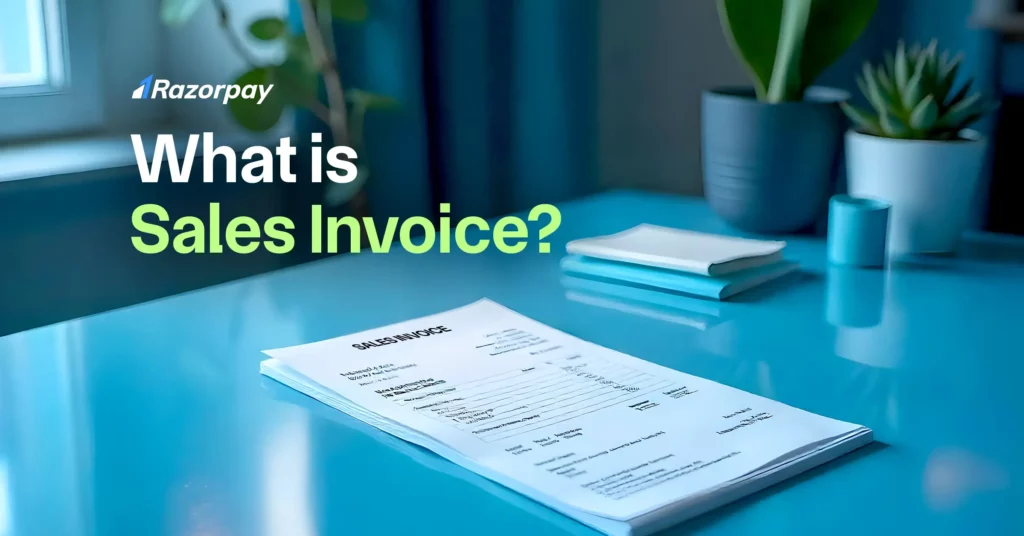Table of Contents
What is Sales Invoice?
A sales invoice is a formal document issued by a seller to a buyer detailing the goods or services provided, their quantity, unit price, applicable taxes and total amount due. It serves as a legal record of the transaction and is typically used to request payment.
Read More About: What is an Invoice?
What is the Purpose of Sales Invoice?
A sales invoice serves several key purposes:
- Legal contract: Formal agreement between buyer and seller.
- Payment request: Detailed request for payment from the buyer.
- Financial record: Essential for tracking income and expenses.
- Customer reference: Provides a clear record of purchases.
- Audit support: Used to verify transactions and ensure compliance.
Related Read: How to Send an Invoice? A Step-by-Step Guide
Key Elements of a Sales Invoice
1. Invoice number
An invoice number is a unique identifier for tracking the invoice, helping both parties in record-keeping and future references.
2. Date of issue
The date when the invoice is generated, which is vital for determining payment deadlines and tax calculations.
3. Seller’s details
The seller’s details includes
- Name of the seller
- Address
- Contact information
- Seller’s GST identification number.
4. Buyer’s details
The buyer’s details includes
- Name of the recipient
- Address
- Contact information
- Add their GST number if applicable.
5. Itemised list of goods/services
Provide a detailed breakdown of the products or services sold.
- Quantities
- Descriptions
- Unit prices
- Any applicable GST rates
6. Total amount due
State the total payable amount. This should be calculated after adding taxes and applying any discounts or adjustments.
7. Payment terms
Specifies when the payment is due, along with accepted payment methods and any late payment penalties.
8. Taxes and discounts
Break down the applicable taxes, such as GST rates. Include any discounts offered on the total bill or specific items.
Example of Sales Invoice Format and Template

Sales invoice templates are available in PDF, Google Docs, Excel, and Word formats. Each format has its advantages, with PDF being more secure for sharing, while Excel and Google Docs are editable and easy to customise for recurring invoices.
Using a sales invoice template simplifies your invoicing processing by saving time and ensuring accuracy. With pre-set fields, you only need to input details like customer information and item descriptions. These templates also ensure consistency in your invoices, reducing the risk of errors and making it easier for you and your customers to track payments.
Types of Sales Invoices
1. Standard Invoice
A standard invoice is the most widely used type for requesting payment. Small businesses commonly use this for everyday transactions, whether selling products or offering services. It outlines the goods or services provided and the total amount due.
2. Credit Invoice
A credit invoice is issued when a refund or discount is applied. It reflects a negative total, reducing the amount the customer owes. This type is typically used for returns, cancellations, or overpayments.
3. Debit Invoice
A debit invoice increases the amount owed by the customer. It’s issued when additional services or charges apply, such as when a project takes longer than expected or when there are unforeseen costs.
4. Commercial Invoice
A commercial invoice is used for international sales. It details cross-border transactions and is essential for customs purposes, providing information on the goods, the buyer and seller, and applicable duties and taxes.
5. Proforma Invoice
A proforma invoice is a preliminary bill sent to a customer before the delivery of goods or services. It provides an estimated cost breakdown, allowing the customer to understand potential expenses. However, the final invoice may differ slightly once the actual goods are delivered or services are completed.
6. Interim Invoice
An interim invoice is used for large projects where payments are made in increments. These invoices are issued periodically throughout the project and are followed by a final invoice once the project is complete.
7. Past-due Invoice
A past-due invoice is sent when a customer hasn’t made a payment by the due date. This invoice may include penalty fees or interest charges to encourage prompt payment.
Read More About: 15 Types of Invoices
How Do Sales Invoices Work?
The sales invoice process typically involves the following steps:
- The seller provides goods or services to the buyer.
- The seller creates a sales invoice detailing the transaction.
- The invoice is sent to the buyer.
- The buyer reviews the invoice and submits payment by the due date.
- The seller records the payment against the invoice and updates their financial records.
How to Create a Sales Invoice? A Step-by-Step Guide
STEP 1: Add Your Business Information
Start by adding your company logo, business name, address, phone number, and email. Ensure all contact information is accurate and professional, as this makes it easier for clients to reach you with any questions.
STEP 2: Add Your Client’s Contact Details
List the customer’s full name, address, and contact information below your business details. If you’re invoicing a larger company, confirm the correct contact person to avoid delays in payment processing.
STEP 3: Generate an Invoice Number
Assign a unique invoice number for easy tracking and reference. You can either create a systematic numbering approach (e.g., INV001, INV002) or use accounting software to automate this process.
STEP 4: List Services or Products Provided
Itemise the products or services you’ve provided. Include brief descriptions, quantities, or hours worked, along with unit rates. This level of detail ensures clarity for the client and reduces the likelihood of disputes.
STEP 5: Specify Payment Terms
Outline the accepted payment methods, such as cash, cheque, or credit card. If you charge interest on late payments, mention the terms clearly to avoid misunderstandings later.
STEP 6: Specify a Payment Due Date
Clearly list the payment deadline. Typically, the due date is calculated based on the invoice date and your specified payment terms (e.g., 30 days from the date of issue).
STEP 7: Calculate and Display the Total Amount Due
Provide the final balance due, including applicable taxes (such as GST). If there are any credits, deposits, or discounts, subtract these from the total amount to give the final payable figure.
Why Are Sales Invoices Important for Small Business Accounting?
1. Basis for Accurate Bookkeeping
- Sales invoices create a clear paper trail of transactions, ensuring every sale is recorded correctly.
- This documentation is vital for tracking sales, monitoring customer payments, and maintaining organised records.
- Accurate sales invoices make it easier to generate financial reports, offering insights into cash flow and profitability.
Resource for Tax Returns
- Sales invoices are indispensable when preparing tax documentation.
- They verify the claims made in tax returns, ensuring that the declared income matches actual sales.
- The Indian tax authorities recommend keeping invoices for audit purposes, as they serve as proof of income and GST compliance.
Tool for Managing Inventory
- For businesses selling physical products, sales invoices help track inventory sold.
- They are integrated into accounting systems to update stock levels, ensuring that inventory records remain accurate.
- This helps avoid stockouts or overstocking, improving efficiency in inventory management.
Provides Legal Protection
- Sales invoices act as legal proof of transactions.
- If any disputes arise with clients regarding the terms of sale or payment, the invoice serves as concrete evidence of what was agreed upon.
- This legal protection is crucial in avoiding misunderstandings and resolving payment issues.
Useful Data for Business Planning
- Sales invoices contain valuable data on revenue and earnings trends over time.
- This data is essential for budget forecasting and can be used to inform strategic decisions.
- By analysing sales invoices, you can identify patterns, adjust pricing strategies, and plan for future business growth.
Best Practices for Creating Sales Invoices
1. Clarity and Conciseness
Ensure your invoice is easy to read, with a straightforward layout. Avoid unnecessary jargon and stick to clear descriptions to prevent any confusion for your clients.
2. Consistency
Use a consistent format for all your invoices, including invoice numbers, layout, and terms. This makes tracking payments easier and presents a more professional image to clients.
3. Accuracy
Double-check all details, such as amounts, tax calculations, and customer information. Accurate invoices reduce the risk of disputes and ensure timely payments.
4. Professional Appearance
Include your company logo, maintain a clean design, and use high-quality fonts. A professional-looking GST invoice enhances your brand image and encourages prompt payment.
5. Legal Compliance
Ensure that your invoices comply with legal requirements, including GST details and accurate business information. This safeguards your business during audits or disputes.
6. Electronic Invoicing
Switch to electronic invoicing for faster delivery and payment. Digital formats like PDFs can be sent instantly, saving time and reducing errors compared to paper invoices.
7. Customer Satisfaction
Offer flexible payment methods and clearly communicate payment terms. Making the invoicing process hassle-free for customers enhances their satisfaction and encourages repeat business.
The Difference Between a Sales Invoice and a Sales Order
Aspect |
Sales Order |
Sales Invoice |
|
Definition |
A document is generated after receiving a customer’s order. |
A document issued after the delivery of goods/services to request payment. |
|
Purpose |
Confirms and outlines the customer’s order details. |
Requests payment for the completed sale. |
|
Timing |
Created before the product or service is delivered. |
Created after the product or service is delivered. |
|
Legal standing |
Serves as a confirmation of the buyer’s intent but does not typically include payment terms |
Serves as proof of transaction and is often used for accounting and tax purposes |
|
Charges |
Lists the agreed-upon price for goods/services. |
May include additional charges such as taxes, shipping, or late fees. |
Conclusion
Professional sales invoices are vital for ensuring efficient payment collection and maintaining clear financial records. They play a crucial role in documenting transactions, managing cash flow, and providing legal protection. A well-crafted invoice streamlines your accounting process, helping you track payments and manage finances more effectively. For greater ease and accuracy, consider using invoicing software, which automates many tasks and reduces the risk of errors, allowing you to focus more on growing your business.
Related Read: Invoice vs Contract: What’s the Difference?
Frequently Asked Questions
1. Is a sales invoice the same as a receipt?
No, a sales invoice is issued before payment is made and serves as a request for payment, while a receipt is provided after payment has been received and confirms the transaction.
2. What are the common payment terms in a sales invoice?
Common payment terms include Net 30 (payment due within 30 days of the invoice date), Due Upon Receipt (payment expected immediately), and 2/10 Net 30 (2% discount if paid within 10 days, otherwise due within 30 days).
3. How can I ensure my sales invoice is legally compliant?
To ensure legal compliance, include necessary details like GST information, business registration numbers, and accurate item descriptions. Following local tax laws and regulations is essential.
4. Who prepares a sales invoice?
The seller or service provider prepares the sales invoice, typically after delivering the product or completing the service.
5. Who receives the sales invoice?
The customer or buyer receives the sales invoice, which outlines the payment details and due amount.
6. Is a sales invoice a debit or credit?
A sales invoice represents a credit for the seller, as it records revenue owed by the customer. It is a debit for the buyer, representing an obligation to pay.
7. What type of account is a sales invoice?
A sales invoice is a document showing a transaction between a business or freelancer and a customer. It will include details of what has been delivered to the buyer and the amount owed for the services provided.


